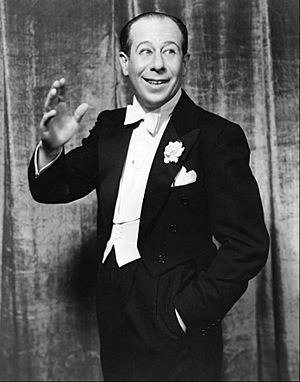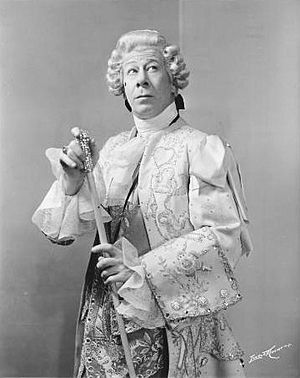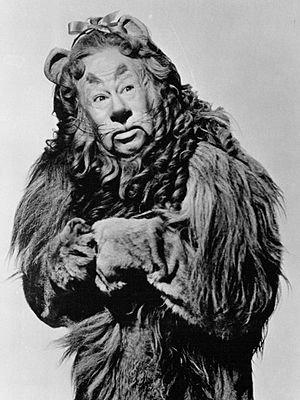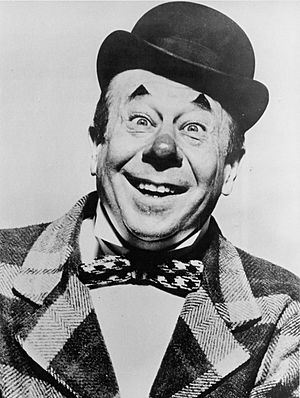Bert Lahr facts for kids
Quick facts for kids
Bert Lahr
|
|
|---|---|

Lahr pictured c. 1936
|
|
| Born |
Irving Lahrheim
August 13, 1895 New York City, U.S.
|
| Died | December 4, 1967 (aged 72) New York City, U.S.
|
| Resting place | Union Field Cemetery, Ridgewood, New York |
| Occupation |
|
| Years active | 1909–1967 |
| Height | 5 ft 9 in (175cm) |
| Spouse(s) |
Mercedes Delpino
(m. 1929; annulled 1939)Mildred Schroeder
(m. 1940) |
| Children | 3, including John and Jane |
| Signature | |
 |
|
Irving Lahrheim (born August 13, 1895 – died December 4, 1967), known professionally as Bert Lahr, was a famous American actor. He worked in theater, movies, and television. Lahr is best remembered for his role as the Cowardly Lion in the 1939 movie The Wizard of Oz. He also played the farmworker "Zeke" in the same film. Bert Lahr was known for his quick humor and his performances in vaudeville (a type of variety show) and on Broadway.
Contents
Bert Lahr's Early Life
Bert Lahr was born Irving Lahrheim on August 13, 1895. His birthplace was in the Yorkville area of Manhattan, New York City. His parents, Augusta and Jacob Lahrheim, were immigrants from Germany. His father worked as an upholsterer.
Lahr went to P.S. 77 and Morris High School. However, he left school when he was 15 years old. During World War I, Lahr served in the U.S. Navy. He was a seaman second class.
Bert Lahr's Stage Career
Lahr started acting in small parts on vaudeville stages when he was just 14. He left school at 15 to join a children's vaudeville group. Eventually, he became a top performer.
In 1927, Lahr made his first appearance on Broadway in a show called Harry Delmar's Revels. He performed popular routines like "The Song of the Woodman." His first big success in a musical was playing a prizefighter in Hold Everything! (1928–29). He also starred in other musicals like Flying High (1930) and The Show is On (1936). In 1939, he acted alongside Ethel Merman in the Broadway show DuBarry Was a Lady. He received great praise for this role.
Later in his career, Lahr performed in Hotel Paradiso on Broadway. He also toured with a company performing A Midsummer Night's Dream in the 1950s. In 1962, he returned to Broadway in the play The Beauty Part.
Bert Lahr's Film Career
Bert Lahr made his first full-length movie in 1931, called Flying High. He played the same unusual aviator character he had played on stage. He then worked for Educational Pictures on a series of short comedies. After that, he moved to Hollywood to act in feature films.
Besides The Wizard of Oz, his movie career was not as extensive. In the 1944 musical comedy Meet the People, Lahr said the funny line "Heavens to Murgatroyd!" This phrase later became famous because of the cartoon character Snagglepuss.
Playing the Cowardly Lion
Lahr's most famous role was the Cowardly Lion in the 1939 movie The Wizard of Oz. He was chosen for the role on July 25, 1938. The lion costume was made of real lion fur. It was extremely hot under the bright lights needed for the movie's Technicolor scenes.
Lahr added many funny lines to his character. Many of his scenes needed several takes because other actors, especially Judy Garland, could not stop laughing. The Cowardly Lion is the only character who sings two solo songs in the movie. These are "If I Only Had the Nerve" and "If I Were King of the Forest."
The Wizard of Oz was Lahr's 17th movie. When someone warned him that Hollywood often gave actors the same type of roles, Lahr joked, "Yeah, but how many parts are there for lions?"
One of the original Cowardly Lion costumes worn by Lahr is now part of The Comisar Collection. This collection has many television items. In 2013, Lahr's original script for The Wizard of Oz was valued at $150,000 on the TV show Antiques Roadshow.
Bert Lahr in Waiting for Godot
Lahr later moved into serious theater roles. He was very impressed by the play Waiting for Godot. However, he was not sure how this new type of play would be received in the United States. It had been very popular in Europe.
He starred in the first U.S. performance of Waiting for Godot in 1956. This was in Miami, Florida. Lahr played Estragon. The show was not a success, and many audience members left. Critics also did not like it. His son, John Lahr, wrote that problems were caused by the director's choices.
Lahr played the role again in a short run on Broadway. This time, he had a new director, Herbert Berghof. The set was simpler, and Lahr had more freedom in his performance. The play became a success and received enthusiastic applause. Bert Lahr was praised, and many believed he understood the play deeply, even though he claimed he did not.
Bert Lahr's Television Work
Lahr appeared on television from time to time. He was in a live version of the musical Let's Face It (1954). He also appeared in The Fantasticks (1964) and as a mystery guest on What's My Line?.
He also performed in commercials. He was famous for a series of ads for Lay's potato chips. In these ads, he appeared in different costumes for the "Betcha can't eat just one" campaign. He also acted in TV versions of classic plays like Androcles and the Lion and School for Wives (1956). In 1959, he played Mr. O'Malley in an episode of General Electric Theater.
Other Notable Work
Among his many Broadway roles, Lahr starred as Skid in the Broadway revival of Burlesque from 1946 to 1948. He also played several characters, including Queen Victoria, in the musical Two on the Aisle (1951–1952). In the late 1950s, he provided the voice of a bloodhound in a cartoon called "Old Whiff."
In 1964, Lahr won the Tony Award for Best Leading Actor in a Musical for his role in the musical Foxy. At the American Shakespeare Festival, he played Bottom in A Midsummer Night's Dream (1960). For this, he received the Best Shakespearean Actor of the Year Award.
Lahr once said about comedy, "Laughter is never too far away from tears." He also reflected, "You will cry at a peddler much easier than you would cry at a woman dressed in ermine who had just lost her whole family."
Bert Lahr's Personal Life
Bert Lahr's first wife, Mercedes Delpino, had mental health problems and was hospitalized. This made his relationship with his second wife, Mildred Schroeder, complicated. He had trouble getting a divorce in New York. Mildred eventually married someone else, which saddened Lahr. However, he later won her back.
Lahr had three children. His son Herbert was with his first wife. His son John (born 1941) and daughter Jane (born 1943) were with Mildred Schroeder. John Lahr became a drama critic. Jane Lahr is an author and editor.
Lahr enjoyed playing golf. Offstage, he was considered a serious person. He was often sad and worried about his health, like his mother. His son John wrote that there were no Wizard of Oz items in their home when he was growing up. He also described his father as a private person who often worried.
Lahr was a strong supporter of the Democratic Party. He supported Adlai Stevenson in the 1952 presidential election.
Bert Lahr's Death
Bert Lahr died on December 4, 1967, at the age of 72. At the time, he was filming The Night They Raided Minsky's. The official cause of death was listed as pneumonia. However, his son John Lahr explained that Bert had returned home sick from the damp film studio. John said that while newspapers reported pneumonia, Bert actually died from cancer. Bert Lahr's father had also died of cancer. The official cause of death was later reported as a massive intestinal hemorrhage.
Most of Lahr's scenes for the film had already been shot. The producers used old test footage of Lahr. They also used an uncredited voice double and a body double, Joey Faye, to finish Lahr's role.
Bert Lahr was buried at the Union Field Cemetery in Ridgewood, Queens, New York.
Bert Lahr's Filmography
- Faint Heart (1929, Short) – Rudolf
- Flying High (1931) – Rusty
- Mr. Broadway (1933) – Himself
- Hizzoner (1933, Short) – Bert Lahr, Cop
- Henry the Ache (1934, Short) – King Henry VIII
- No More West (1934, Short) – Gunpowder Bert
- Gold Bricks (1936, Short) – Bert
- Boy, Oh Boy (1936, Short) – The Butler
- Whose Baby Are You? (1936, Short) – Bert Halibut
- Off the Horses (1937, Short) – Chester Twitt
- Montague the Magnificent (1937, Short) – Egbert Bunting / Roland Montague
- Merry Go Round of 1938 (1937) – Bert Lahr
- Love and Hisses (1937) – Sugar Boles
- Josette (1938) – Barney Barnaby
- Just Around the Corner (1938) – Gus
- Zaza (1939) – Cascart
- The Wizard of Oz (1939) – 'Zeke' / The Cowardly Lion
- Sing Your Worries Away (1942) – Clarence 'Chow' Brewster
- Ship Ahoy (1942) – 'Skip' Owens
- Meet the People (1944) – The Commander
- Always Leave Them Laughing (1949) – Eddie Eagen
- Mister Universe (1951) – Joe Pulaski
- Rose Marie (1954) – Barney McCorkle
- Anything Goes (1954) - “Moonface” Martin
- The Second Greatest Sex (1955) – Job McClure
- The Night They Raided Minsky's (1968) – Professor Spats (final film role)
Bert Lahr's Stage Productions
- Harry Delmar's Revels (1927)
- Hold Everything! (1928)
- Flying High (1930)
- George White's Music Hall Varieties (1932)
- Life Begins at 8:40 (1934)
- George White's Scandals of 1936 (1936)
- The Show is On (1936)
- DuBarry Was a Lady (1939)
- Seven Lively Arts (1944)
- Burlesque (1946)
- Two on the Aisle (1951)
- Waiting for Godot (1956)
- Hotel Paradiso (1957)
- The Girls Against the Boys (1959)
- The Beauty Part (1962)
- Foxy (1964)
- Never Too Late (1965)
- The Birds (1966)
See also
 In Spanish: Bert Lahr para niños
In Spanish: Bert Lahr para niños





